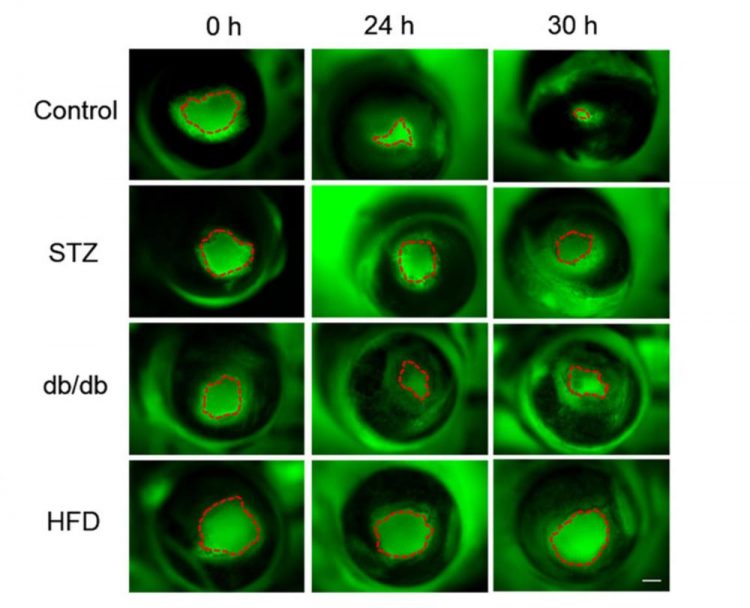Electric fields weaker in slow-healing diabetic wounds

UC Davis researchers measured electric fields and wound healing in eyes from three different models of diabetes. Left to right, green fluorescence shows damaged area shrinking over time. Top row, eyes from normal mice. Other rows are eyes from three different mouse models of diabetes. Credit: Min Zhao and Brian Reid, UC Davis
“This is the first demonstration, in diabetic wounds or any chronic wounds, that the naturally occurring electrical signal is impaired and correlated with delayed healing,” Zhao said. “Correcting this defect offers a totally new approach for chronic and nonhealing wounds in diabetes.”
It has been estimated that as much as $25 billion a year is spent on treating chronic ulcers and wounds related to diabetes, Zhao said.
Electric fields and wound healing
Electric fields are associated with living tissue. Previous work by Zhao and Brian Reid, project scientist at the UC Davis Department of Dermatology, showed that electric fields are associated with healing damage to the cornea, the transparent outer layer of the eye.
In the new work, published June 10 in the journal Scientific Reports, Zhao, Reid and colleagues used a highly sensitive probe to measure electrical fields in the corneas of isolated eyes from three different lab mouse models with different types of diabetes: genetic, drug-induced and in mice fed a high-fat diet.
In a healthy eye, there is an electrical potential across the thickness of the cornea. Removing a small piece of cornea collapses this potential and creates electric currents, especially at the edges of the wound. Cells migrate along the electric currents, closing the scratch wound in about 48 hours.
The researchers found that these electric currents were much weaker in eyes from all three strains of diabetic mice than in healthy mice. Delayed wound healing was correlated with weaker electric currents.
“We saw similar results with all three models,” Reid said.
The researchers also found that human corneal cells exposed to high levels of glucose showed less response to an electric field. Diabetics have high levels of glucose in their tears, Reid noted.
Unique facility
The UC Davis bioelectricity laboratory is one of a very few able to make such sensitive measurements of electric fields in living tissue.
“We might be the only lab in the country that is able to do this,” Reid said. They are collaborating with a number of laboratories worldwide and across the country, as well as several other UC Davis departments.
###
Other co-authors on the paper are: at UC Davis, Yunyun Shen (also at Zhejiang University, China), Trisha Pfluger, Fernando Ferreira (also at University of Minho, Portugal) and Manuel Navedo; Jiebing Liang, CSU Northridge; and Qunli Zeng, Zhejiang University. The work was supported by the National Eye Institute (National Institutes of Health) and Research to Prevent Blindness Inc.
Media Contact
All latest news from the category: Health and Medicine
This subject area encompasses research and studies in the field of human medicine.
Among the wide-ranging list of topics covered here are anesthesiology, anatomy, surgery, human genetics, hygiene and environmental medicine, internal medicine, neurology, pharmacology, physiology, urology and dental medicine.
Newest articles

High-energy-density aqueous battery based on halogen multi-electron transfer
Traditional non-aqueous lithium-ion batteries have a high energy density, but their safety is compromised due to the flammable organic electrolytes they utilize. Aqueous batteries use water as the solvent for…

First-ever combined heart pump and pig kidney transplant
…gives new hope to patient with terminal illness. Surgeons at NYU Langone Health performed the first-ever combined mechanical heart pump and gene-edited pig kidney transplant surgery in a 54-year-old woman…

Biophysics: Testing how well biomarkers work
LMU researchers have developed a method to determine how reliably target proteins can be labeled using super-resolution fluorescence microscopy. Modern microscopy techniques make it possible to examine the inner workings…





















